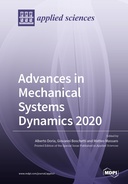Explore

Advances in Mechanical Systems Dynamics 2020
0 Ungluers have
Faved this Work
Login to Fave
The fundamentals of mechanical system dynamics were established before the beginning of the industrial era. The 18th century was a very important time for science and was characterized by the development of classical mechanics. This development progressed in the 19th century, and new, important applications related to industrialization were found and studied. The development of computers in the 20th century revolutionized mechanical system dynamics owing to the development of numerical simulation. We are now in the presence of the fourth industrial revolution. Mechanical systems are increasingly integrated with electrical, fluidic, and electronic systems, and the industrial environment has become characterized by the cyber-physical systems of industry 4.0. Within this framework, the status-of-the-art has become represented by integrated mechanical systems and supported by accurate dynamic models able to predict their dynamic behavior. Therefore, mechanical systems dynamics will play a central role in forthcoming years. This Special Issue aims to disseminate the latest research findings and ideas in the field of mechanical systems dynamics, with particular emphasis on novel trends and applications.
This book is included in DOAB.
Why read this book? Have your say.
You must be logged in to comment.
Rights Information
Are you the author or publisher of this work? If so, you can claim it as yours by registering as an Unglue.it rights holder.Downloads
This work has been downloaded 89 times via unglue.it ebook links.
- 89 - pdf (CC BY) at Unglue.it.
Keywords
- active rear axle independent steering (ARIS) system
- ADAS
- articulated vehicle
- ball passage frequency
- bicycle
- Biomechanics
- body segment inertial parameters
- cable failure
- cable robots
- chain efficiency
- Compliance
- computational fluid dynamics
- contact model
- conveyor
- coupled approach
- damping force
- deformable soil
- directional stability
- Driver Model
- dynamic parameter identification
- dynamic parameters
- Dynamics
- e-bike
- fluid sloshing
- force and moment
- fork bending compliance
- fractal derivative
- Friction
- FSAE vehicle
- handling stability
- hierarchical synchronization control
- History of engineering & technology
- Human body
- hydraulic steering system
- hydraulic system
- impulsive testing
- internal radial clearance
- Isolation
- lateral offset
- lightweight
- linear active disturbance rejection control (LADRC)
- load
- load cell
- Machining
- magnetic spring
- modes of vibration
- Motion Planning
- motorcycle
- motorcycle tires
- mountain bike
- multi-physics mechanism theory
- multibody
- n/a
- non-linear simulation
- non-linear stiffness
- number of rolling elements
- NVH
- parallel kinematics
- parallel manipulator
- parallel robot
- performance optimization
- Polymers
- real-time simulations
- recovery strategy
- RIDER
- rider influence
- rigid rotor
- robot
- roller chain
- Rolling
- rolling bearing
- sliding friction
- steering wheel
- step steer
- suspension
- table cart method
- taper-leaf spring
- Technology, engineering, agriculture
- Technology: general issues
- thermal modeling
- tire model
- tire temperature
- tire tread pattern
- tracked vehicle
- Trucks
- two-wheeler
- tyre
- valve train
- varying compliance vibration
- varying friction
- vehicle dynamic modelling
- Vibration
- vibration energy control
- virtual coupling control
- viscoelastic models
- weave
- wobble
- zero moment point
Links
DOI: 10.3390/books978-3-0365-2871-7Editions

